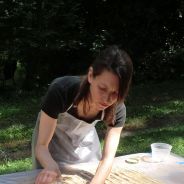This Friday, November 13th, Houghton College will host an exhibition by Tatiana Ginsberg, a master artist in papermaking, printmaking, installation media, and drawing. This exhibition was brought to Houghton because of Ginsberg’s expertise and talent. She was a Fulbright scholar to Japan, where she studied various techniques and styles which influence her work. She also studied with Tim Barrett, an internationally-acclaimed papermaker and paper historian, at the University of Iowa, who won a Macarthur ‘Genius’ grant for his work. Ginsberg has also taught many workshops on papermaking, the use of natural dyes, and Japanese-style paper.

The exhibit, I Fear We Must Go, features a combination of drawings and text which reflect upon the story of Robert Wilson and his crews’ Antarctic expedition of 1911-1912. It was during this excursion that the first British explorers reached the South Pole. However, as the group separated more and more throughout their journey, only five of their members were able to arrive at the South Pole. Upon reaching their destination, they found a Norwegian flag planted at the site, which took away much of the glory of completing this goal. None of these five men survived the journey back, and their bodies were found the next year along with Robert Wilson’s collection of letters and journal entries detailing the events of their expedition.
Hung about the room are several huge pieces of handmade paper with detailed, coloured pencil drawings upon them. These abaca sheets are immense, and required hours of work; additionally Ginsberg required the assistance of another person to complete the process. Ginsberg said of her work, “I think through materials, and making my own paper is the most important of these.” This brings the creation of the piece to the very beginning of the composition, when the paper upon which her forms are composed was made.
The drawings are affixed simply to the walls with magnets, to give the paper room to expand and contract as it will, without tearing or being compromised. The quality and texture of the paper is simple and organic, with subtle irregular curves throughout each. This gives the pieces an intimate, anthropomorphic quality, as they represent the men who died in the ice of Antarctica.
The drawings are of the “shadows of leaves,” leaves which have been eaten by insects and rotted away and have lace-like, well-worn forms. The many layers of colour carefully used in each one creates a watery, fluid effect, which changes the colours drastically as the viewer steps closer to the piece. Each leaf was chosen carefully, with the intent of reflecting the person it represents accurately – gingko, sycamore, and so on.
Ginsberg has also arranged several phrases, sentences and paragraphs from Robert Wilson’s letters around the room to bring some context to the drawings. On one wall, the majority of a letter from March 16, 1912 is placed along with the latitude at which it was written: 79.5 degrees. These texts are extraordinarily moving, and bring the viewer to consider the full consequence of such an experience.
Ginsberg said that “even if you don’t know what inspired” [her], she hopes that this exhibition will be influential regardless, that “people may find it a contemplative space.” By placing text on the floor of the Ortlip Gallery, a makeshift path is created throughout the pieces, guiding the viewers in their own excursion within the exhibition. The usage of soft lighting encourages visitors to come close to the drawings and examine their every detail. Through the simplicity of her composition, Ginsberg has created an opportunity for profound consideration of her work.
